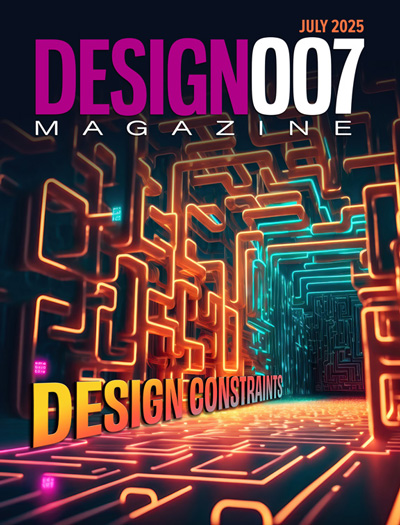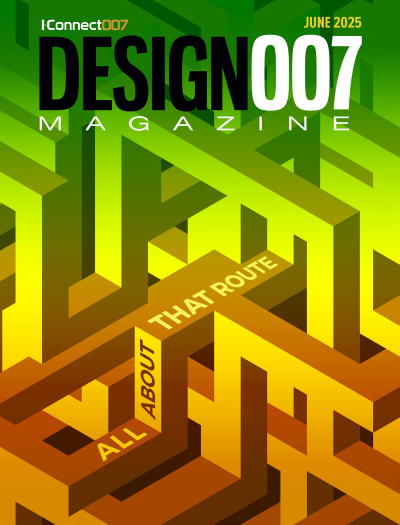-

- News
- Books
Featured Books
- design007 Magazine
Latest Issues
Current Issue
Proper Floor Planning
Floor planning decisions can make or break performance, manufacturability, and timelines. This month’s contributors weigh in with their best practices for proper floor planning and specific strategies to get it right.

Showing Some Constraint
A strong design constraint strategy carefully balances a wide range of electrical and manufacturing trade-offs. This month, we explore the key requirements, common challenges, and best practices behind building an effective constraint strategy.

All About That Route
Most designers favor manual routing, but today's interactive autorouters may be changing designers' minds by allowing users more direct control. In this issue, our expert contributors discuss a variety of manual and autorouting strategies.
- Articles
- Columns
- Links
- Media kit
||| MENU - design007 Magazine
DFM 101: PCB Materials
April 30, 2021 | Anaya Vardya, American Standard CircuitsEstimated reading time: 6 minutes
Introduction
One of the biggest challenges facing PCB designers is understanding the cost drivers in the PCB manufacturing process. This article is the first in a series that will discuss these cost drivers (from the PCB manufacturer’s perspective) and the design decisions that will impact product reliability.
DFM
Design for manufacturing (DFM) is defined as the practice of designing printed circuit boards that meet not only the capabilities of the customer’s assembly manufacturing process, but also the capabilities of the board fabrication process at the lowest possible cost. While not a substitute for early design engagement with the PCB fabricator, these articles will provide guidelines that will help you to “design for success.”
Standard Multilayer Materials
Most PCBs are manufactured using epoxy-glass (FR-4) dielectrics and copper foil. PCBs are constructed from three basic material types: copper foil, prepreg, and cores.
- Copper foil: Sheets of copper foil are incorporated into the outer layer of the PWB placing it on the prepreg to create the outer layers. Outer layers are generally constructed using 0.5-ounce copper. Internal layers are constructed with copper that is specified on the fabrication print. 1-ounce foil is generally preferred; 0.5-ounce is commonly used for signal layers with fine lines, and 2-ounce copper is used for power planes where there is a high DC current.
- Prepreg: This is semi-cured glass-epoxy material. There is no copper attached to this material.
- Core: This is fully-cured glass-epoxy material with copper laminated to both sides (Figure 1). This is used for internal layers. It is occasionally used for outer layers but is not preferred. A core is constructed from either of one sheet of prepreg (single-ply) or two or more sheets of prepreg and two layers of copper foil. Single-ply is considered the preferred core construction and has better dimensional stability.
Figure 1: An example of fully-cured glass-epoxy material with copper laminated to both sides.
High Frequency (RF/Microwave) Materials
High-frequency designs (1 GHz and up) require materials with closely controlled dielectric constants and dissipation factors. The FR-4 materials normally used for PCBs don’t have the desired controlled characteristics. The substrate materials used for high frequency applications were originally based upon PTFE resin formulations that have the desired properties, i.e., dielectric constant controlled to ±0.04 and dissipation factor to 0.0004. These values may vary somewhat depending on the material type and supplier. Today, there are a number of materials on the market that do not contain PTFE, but still have controlled values that can be used for high frequency applications.
Material Types
There are three basic material types: non-woven glass, woven glass, and filled. Military specification designations are GR (non-woven) and GT, GX, and GY (woven). Filled material has no designation.
Non-woven materials contain a dispersion of glass microfibers in the substrate. These are typically materials with low dielectric constants (2.20-2.35). They work very well at the higher frequencies, as the dissipation factor is low.
- Woven glass materials are made using fine weave glass fiber cloth. These materials have dielectric constants in the range of 2.40 to 2.60. Due to the glass cloth, the dissipation factor may be somewhat higher.
- Filled materials have dielectric constants ranging from 2.94 to 10.8. The filler material may be a ceramic or other suitable material that can be used to raise the dielectric constant. These materials may also contain non-woven or woven glass. The type of filler and construction determines the dielectric constant as well as the dissipation factor. These materials tend to have a higher dissipation factor than the materials mentioned above.
Copper Foil Types
Two types of bonded copper foil are available; electrodeposited (ED) and rolled-annealed (RA). The difference between these foils is the fabrication process and the treatment on the backside to enhance bonding adhesion.
1. Electrodeposited copper (ED) is made by electroplating copper onto a rotating drum that results in a vertically-oriented grain structure (Figure 2). Opposite the drum surface, the copper plating is rough, almost like “teeth,” and enhanced by further treatment. The teeth provide higher peel strength but may increase conductor losses at high frequency because of the depth of the teeth.
Figure 2: Electrodeposited copper made by electroplating onto a rotating drum.
2. Rolled-annealed copper (RA) is made by rolling an ingot to very thin foils. The grain structure is horizontally oriented. The rolling causes stress in the foil and must be heat annealed to remove the stress. Rolled-annealed copper has the same finish on each side, which requires teeth artificially created on the backside. These teeth are about half the depth of the electrodeposited copper. This causes rolled-annealed copper to have about half the peel strength of electrodeposited copper. This means rolled-annealed copper performs better at frequencies above 13 GHz.
Figure 3: Rolled-annealed (RA) copper is made by rolling an ingot into very thin foils.
Peel strength is the amount of force, in pounds per inch, which must be applied to cause a 1-inch-wide strip of the copper foil to peel from the substrate. Typical values for electrodeposited (ED) 1-ounce copper are 9–11 pounds per inch and rolled-annealed (RA) 1 ounce copper is 4–6 pounds per inch. As circuit traces become narrower the peel strength is reduced. Therefore, more care is required to solder and bond to narrow traces.
Copper surface roughness is critical for high-frequency applications where the roughness of the copper surface impacts conductor loss. At high signal frequencies, the current in a PCB copper circuit is concentrated within a small depth near its surface, referred to as the skin effect, or skin depth. Skin depth is a measure of how (and where) electrical conduction takes place in a conductor and is a function of frequency.
In other words, for high frequency applications, the smoother the surface copper the better. Circuit conduction occurs at the surface nearest the dielectric from which the EM wave propagates, in other words, the bottom copper surface that is against the laminate in a microstrip design.
Figure 4: The smoother the surface of copper, the better.
Metal Core and IMPCB Materials
Insulated metal printed circuit boards (IMPCB) or metal core PCBs are thermal management designs that utilize a layer of solid metal to dissipate the heat generated by the various components on the PCBs. When metal is attached to a PCB, the bonding material can either be thermally conductive but electrically isolative, or in the case of RF/microwave circuits, the bonding material may be both electrically and thermally conductive. There are two common metals used in these applications: copper and aluminum. Which to use depends on the application with consideration for cost, weight, and thermal properties. Table 1 presents the properties of the various base metals.
Table 1: A list of various properties of a few metal base materials.
Embedded Capacitance Materials
Embedded capacitance material consists of a very thin layer of ceramic-filled epoxy sandwiched between two layers of copper foil. It can be patterned as a power and ground plane pair for a lower impedance, shared capacitance power distribution network. The biggest design benefit is that it increases the usable board area by allowing for the removal of many, if not all, capacitors equal to or below 0.1 ?F and their associated solder joints and vias. Additional benefits include:
- Better power delivery
- Lower profile
- Low inductance and impedance
- Thickness and weight reduction
- Higher reliability
Embedded Resistor Materials
Embedded resistors are planar resistive elements made into a thin film. This type of resistor becomes part of the etched and printed circuitry on the standard printed circuit board layer as it eliminates the need for solder joints.
Additional benefits include:
- Improves line impedance matching
- Reduces signal paths and series inductance
- Reduces crosstalk, noise and EMI
- Enhances performance of cost-effective resistor technology in high-speed high-density designs
- Eliminates discrete resistors and reduces assembly time
- Stable through a wide frequency range, 20+ Ghz
Conclusion
As you can see, there are many manufacturing factors that contribute to the final cost of every PCB. Today’s PCB designer must have a thorough understanding of these cost drivers, as well as the many trade-offs involved in managing these factors in each design. Stay tuned for Part 2 of this series.
Anaya Vardya is president and CEO of American Standard Circuits; co-author of The Printed Circuit Designer’s Guide to… Fundamentals of RF/Microwave PCBs and Flex and Rigid-Flex Fundamentals; and author of Thermal Management: A Fabricator's Perspective. Visit I-007eBooks.com to download these and other free, educational titles. He also co-authored “Fundamentals of Printed Circuit Board Technologies.”
Testimonial
"Advertising in PCB007 Magazine has been a great way to showcase our bare board testers to the right audience. The I-Connect007 team makes the process smooth and professional. We’re proud to be featured in such a trusted publication."
Klaus Koziol - atgSuggested Items
Integrated Solutions for Board-level Reliability: A Smarter Path Forward
08/27/2025 | Alan Gardner, MacDermid Alpha Electronic SolutionsIn today’s electronics manufacturing landscape, reliability is no longer just a benchmark but a business imperative. As industries such as automotive, aerospace, and high-performance computing (HPC) push the boundaries of innovation, the demand for dependable board-level performance under extreme conditions has never been greater.
ZESTRON Expands Capabilities with Addition of the EPS by i-Tech AG 75 Pallet Cleaning System
08/26/2025 | ZESTRONZESTRON, the global leader in high-precision cleaning solutions and services, is excited to announce the addition of a new capability in its Technical Center in Manassas, VA:
Pick and Place Machine Innovator - NECTEC Launches Next-Gen SMT Line Solution With LED and X-ray Technology
08/26/2025 | Globe NewswireNECTEC PTE. LTD., a leading provider of SMT electronics manufacturing equipment, announced the official launch of its next-generation SMT solutions, featuring newly upgraded pick and place machine, specialized LED pick and place machines, enhanced Reflow Oven technology, advanced X-ray Inspection, high-speed X-ray Counter, and premium Solder Paste
MS2 Technologies, LLC/P. Kay Focuses on Central America with First Installation in Honduras
08/24/2025 | P. Kay Metal, Inc.This year MS2 Technologies has turned their focused to the growing electronics market in Central America. With that focus came the adaptation of MS2 and the Akila System from a Honduras-based corporation with manufacturing plants in both Honduras and Mexico.
BEST Inc. Provides High-Reliability BGA Reballing and Component Rework Services
08/22/2025 | BEST Inc.BEST Inc., a leader in electronic component services, is pleased to announce its component rework services are available for all types of area array devices including ball grid array, land grid array and quad flat no-lead SMT packages.


